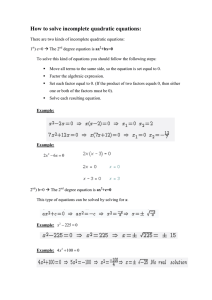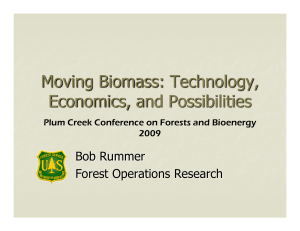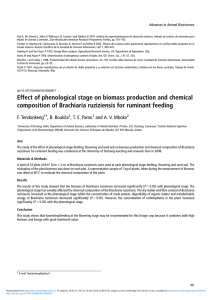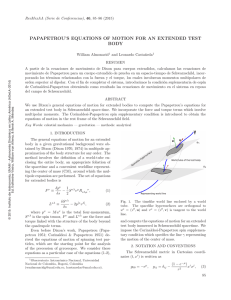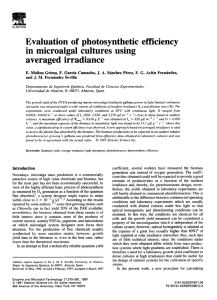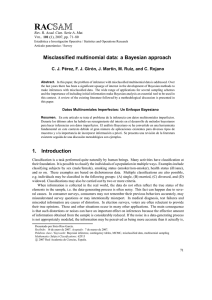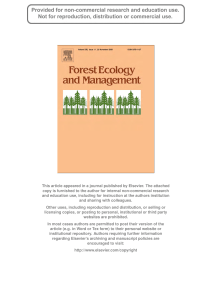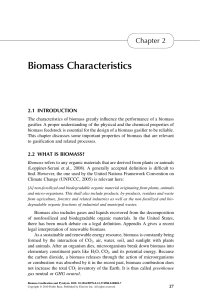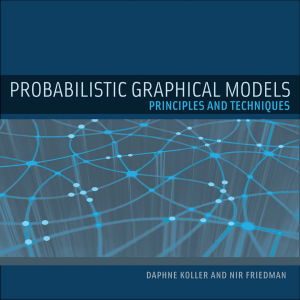Probability distribution of allometric coefficients and Bayesian
Anuncio
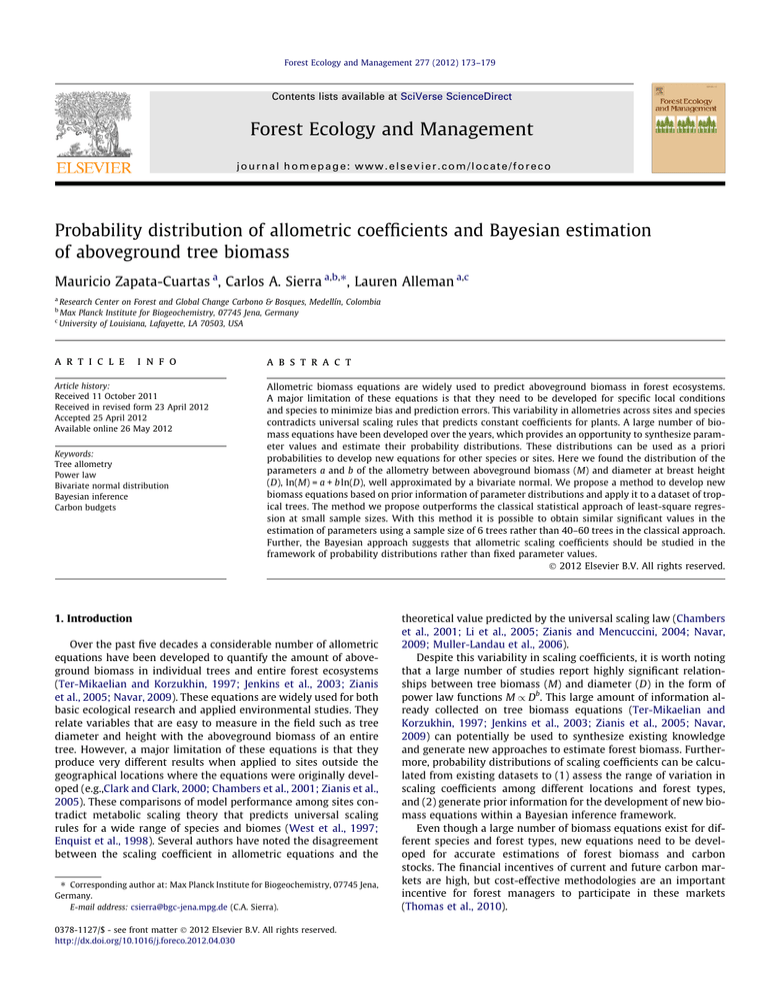
Forest Ecology and Management 277 (2012) 173–179 Contents lists available at SciVerse ScienceDirect Forest Ecology and Management journal homepage: www.elsevier.com/locate/foreco Probability distribution of allometric coefficients and Bayesian estimation of aboveground tree biomass Mauricio Zapata-Cuartas a, Carlos A. Sierra a,b,⇑, Lauren Alleman a,c a Research Center on Forest and Global Change Carbono & Bosques, Medellín, Colombia Max Planck Institute for Biogeochemistry, 07745 Jena, Germany c University of Louisiana, Lafayette, LA 70503, USA b a r t i c l e i n f o Article history: Received 11 October 2011 Received in revised form 23 April 2012 Accepted 25 April 2012 Available online 26 May 2012 Keywords: Tree allometry Power law Bivariate normal distribution Bayesian inference Carbon budgets a b s t r a c t Allometric biomass equations are widely used to predict aboveground biomass in forest ecosystems. A major limitation of these equations is that they need to be developed for specific local conditions and species to minimize bias and prediction errors. This variability in allometries across sites and species contradicts universal scaling rules that predicts constant coefficients for plants. A large number of biomass equations have been developed over the years, which provides an opportunity to synthesize parameter values and estimate their probability distributions. These distributions can be used as a priori probabilities to develop new equations for other species or sites. Here we found the distribution of the parameters a and b of the allometry between aboveground biomass (M) and diameter at breast height (D), ln(M) = a + b ln(D), well approximated by a bivariate normal. We propose a method to develop new biomass equations based on prior information of parameter distributions and apply it to a dataset of tropical trees. The method we propose outperforms the classical statistical approach of least-square regression at small sample sizes. With this method it is possible to obtain similar significant values in the estimation of parameters using a sample size of 6 trees rather than 40–60 trees in the classical approach. Further, the Bayesian approach suggests that allometric scaling coefficients should be studied in the framework of probability distributions rather than fixed parameter values. Ó 2012 Elsevier B.V. All rights reserved. 1. Introduction Over the past five decades a considerable number of allometric equations have been developed to quantify the amount of aboveground biomass in individual trees and entire forest ecosystems (Ter-Mikaelian and Korzukhin, 1997; Jenkins et al., 2003; Zianis et al., 2005; Navar, 2009). These equations are widely used for both basic ecological research and applied environmental studies. They relate variables that are easy to measure in the field such as tree diameter and height with the aboveground biomass of an entire tree. However, a major limitation of these equations is that they produce very different results when applied to sites outside the geographical locations where the equations were originally developed (e.g.,Clark and Clark, 2000; Chambers et al., 2001; Zianis et al., 2005). These comparisons of model performance among sites contradict metabolic scaling theory that predicts universal scaling rules for a wide range of species and biomes (West et al., 1997; Enquist et al., 1998). Several authors have noted the disagreement between the scaling coefficient in allometric equations and the ⇑ Corresponding author at: Max Planck Institute for Biogeochemistry, 07745 Jena, Germany. E-mail address: [email protected] (C.A. Sierra). 0378-1127/$ - see front matter Ó 2012 Elsevier B.V. All rights reserved. http://dx.doi.org/10.1016/j.foreco.2012.04.030 theoretical value predicted by the universal scaling law (Chambers et al., 2001; Li et al., 2005; Zianis and Mencuccini, 2004; Navar, 2009; Muller-Landau et al., 2006). Despite this variability in scaling coefficients, it is worth noting that a large number of studies report highly significant relationships between tree biomass (M) and diameter (D) in the form of power law functions M / Db. This large amount of information already collected on tree biomass equations (Ter-Mikaelian and Korzukhin, 1997; Jenkins et al., 2003; Zianis et al., 2005; Navar, 2009) can potentially be used to synthesize existing knowledge and generate new approaches to estimate forest biomass. Furthermore, probability distributions of scaling coefficients can be calculated from existing datasets to (1) assess the range of variation in scaling coefficients among different locations and forest types, and (2) generate prior information for the development of new biomass equations within a Bayesian inference framework. Even though a large number of biomass equations exist for different species and forest types, new equations need to be developed for accurate estimations of forest biomass and carbon stocks. The financial incentives of current and future carbon markets are high, but cost-effective methodologies are an important incentive for forest managers to participate in these markets (Thomas et al., 2010). 174 M. Zapata-Cuartas et al. / Forest Ecology and Management 277 (2012) 173–179 The objective of this study was to compile a dataset on allometric equations and derive probability distributions of their parameters. Further, we aimed to develop a procedure based on a Bayesian framework to obtain efficient site-specific allometric equations. We show by simulation that this approach performs significantly better at small sample sizes compared with the performance of the classical statistical approach. We tested the Bayesian approach and provide an example using a dataset of biomass of tropical trees. 2. Methods 2.1. Theoretical argument The allometric relationship between tree mass M and its diameter D is given by a function M ¼ f ðDjhÞ; ð1Þ where h are parameters. Values for h can be obtained by minimum least squares (MLS) or maximum likelihood estimation (MLE), in the classical statistical approach. In the bayesian framework, h has a probability distribution that can be calculated given some observed data as pðhjDÞ ¼ R pðhÞf ðDjhÞ : pðhÞf ðDjhÞdh ð2Þ Prior probabilities for the parameters of any allometric equation are given by p(h). These prior probabilities can be obtained from reported parameters from the literature. For the development of new biomass equations, the problem resides in finding p(hjD). We assume that the existing biomass equations reported in the literature can provide useful information to derive probability distributions. 2.2. Allometric model In this analysis we considered the simple allometric function between tree diameter (units in cm) and aboveground biomass given by M i ¼ aDbi vi ð3Þ where Mi is the dry mass of the ith tree in the sample (units in kg); a and b are parameters of the model, and vi is a multiplicative error term with lognormal distribution (Heien, 1968). Logarithmic transformation of this equation is convenient to facilitate model fitting and deal with heterocedasticity (Overman et al., 1994) lnðMi Þ ¼ a þ b lnðDi Þ þ ei : ð4Þ In this case a = ln(a) and b are parameters, and ei is the error term, which is normally distributed with mean zero and variance r2. In classical analyses the parameters of this model are estimated using MLS or MLE approaches. The MLS approach will be used here as a control to compare with the Bayesian approach we propose. We propose finding estimates of the parameters of the linear allometric model using a Bayesian procedure to include a priori information collected from other allometric models reported in the literature and improve the efficiency in the estimation. In applications, it is necessary to back-transform biomass predictions from Eq. (4) to the original scale. It is well known that this procedure introduces bias and a correction factor must be applied (Heien, 1968; Chave et al., 2005). It is not clear to us how correction factors could best be incorporated into the Bayesian approach, and thus our Bayesian analyses include no correction factors. Therefore, inferences in this analysis apply only to the untransformed values of the parameters. 2.3. Compilation of the database The following information was collected from the primary literature: values of the parameters a and b of Eq. (4), species, forest type (boreal, temperate, or tropical), latitude and longitude of the study site, sample size (N), minimum and maximum diameter of the trees in the sample, coefficient of determination (R2), standard error of estimation (SEE), and correction factor. Each original source was coded with a reference number that was also included in the database. In total, over 72 articles were utilized to construct this database, several of which were databases themselves (e.g., Ter-Mikaelian and Korzukhin, 1997; Jenkins et al., 2003; Zianis et al., 2005; Navar, 2009). After compiling the database we performed preliminary statistical analysis to identify extreme observations. Box-plots were constructed to identify extreme observations with the criteria that values outside the 1.5 interquartile range of the data are outliers (Tukey, 1977). The outliers in the dataset were isolated and researched by reviewing the original literature (if available). Potential causes of outliers include, but were not limited to: using the age of a stand of trees instead of D to estimate biomass, the presence of very large trees in the sample, unusual or highly specialized forest types such as savannah woodland and dry scrub forest, or original biomass and diameter data in units different than kilograms and centimeters. In some cases we were able to confirm the cause of outliers and made corrections to erroneous reports. When we were unable to confirm the cause of outliers due to the inability to locate the primary sources, we removed them from the dataset to avoid including erroneous datapoints. This only occurred for three equations in the original database. 2.4. Bayesian implementation To implement the Bayesian approach we used the R package MCMCglmm (Hadfield, 2010) that implements Markov chain Monte Carlo techniques to fit generalized linear models, including the linear Gaussian model. However, given the simplicity of this model, it can be implemented in any statistical software that includes Bayesian parameter estimation for linear models. To specify the model of Eq. (4) in MCMCglmm, we assumed the parameters a and b distributed as a bivariate normal distribution Nðl; RÞ, where l = (la, lb) is a vector of means, and R is the covariance matrix. In our implementation, we specified the hyperparameters of l and R from the database of biomass equations selected by forest type (Table 1). In this Gaussian linear model, we assumed that the errors are normally distributed ei N(0, r2). In MCMCglmm this residual variance was specified with a univariate inverse Wishart distribution that only takes two scalar parameters, V and m. In our simulations, the scalar parameters of the prior inverse Wishart of r2 were set to V = 1 and m = 0.001 as recommended by Hadfield (2010). MCMCglmm uses Gibbs sampling to update the parameters, using only one chain for each parameter. However, we specified a sufficiently large number of iterations on three parallel independent Table 1 Parameter values of the normal bivariate distribution by forest type. Biome Boreal Temperate Tropical la 2.545 3.215 2.037 lb R 2.270 2.383 2.415 Num. of equations 1:949 0:135 0:135 0:051 3:103 0:153 0:153 0:058 0:357 0:081 0:081 0:034 45 45 44 175 M. Zapata-Cuartas et al. / Forest Ecology and Management 277 (2012) 173–179 chains at each step of the simulation to assess convergence of the posterior distributions. In our case, 25,000 iterations were sufficient to achieve convergence, using three chain for each parameter, discarding the first half of the Markov chains, and taking one of every three of the iterations for the summary statistics. To diagnose convergence, we used the method proposed by Gelman and Rubin (1992) implemented in the R package Coda (Plummer et al., 2006). 3.0 2.8 2.5. Tree biomass data ● ● ● ● ●●● ● ● ● ● ●● ● ● ● ●● ● ● ● ● ● ● ●● ● ● ● ● ● ● ● ● ● ● 2.0 1.8 −4 −3 −2 −1 0 a Fig. 2. Graphical summary of the parameters a and b of the complete dataset. Bars are frequency distributions for a (top and x-axis) and b (right and y-axis). Data points for boreal, temperate, and tropical forests are represented by squares, triangles, and circles, respectively. The dashed lines are the mean values for the two parameters. Colors and contour lines represent probability values from a bivariate normal distribution. (For interpretation of the references to colour in this figure legend, the reader is referred to the web version of this article.) narrow range, are normally distributed, and negatively correlated with each other (Fig. 2). The dataset suggests that the parameters a and b are well represented by a bivariate normal distribution, with mean la = 2.069, lb = 2.356, and covariance matrix R¼ A total of 134 biomass equations in logarithmic form were compiled from the literature. Although multiple equations were developed at the same sites, the database has a wide geographical distribution (Fig. 1); and even though these equations are reported either by species or forest type, their parameters converge in a ● 2.2 3. Results 3.1. Descriptive statistics and parameter distributions ●● ● 2.4 ● ● ● ● 2.6. Comparison between the classical and the Bayesian approach To show the advantages of our Bayesian approach, simulations were performed using subsamples from a sample of 257 independent trees. We compared the estimated value of the parameters a and b with the Bayesian approach and the estimates from the classical MLS approach. In the simulations, predefined sample sizes of 200, 150, 100, 80, 60, 40, 30, 20, 15, 10, and 6 trees were sampled without replacement from the entire dataset (257 trees), repeating the procedure 1000 times. With each subsample, we estimated parameter values using both the classical MLS and the Bayesian approaches. Every parameter set estimated in the simulation was used to calculate the biomass of the original sample of trees (n = 257). This gives a measure of the efficiency of the estimation in terms of the error for the different sample sizes. Simulations were performed in the R environment for statistical computing (R Development Core Team, 2011), using the MCMCglmm package (Hadfield, 2010) for fitting the Bayesian models. ● 2.6 b To test the performance of the model proposed here, we used a dataset of aboveground tree biomass collected in a tropical forest of the Porce region of Colombia (Zapata, 2001; Sierra et al., 2007). This dataset consist of 257 trees felled and weighed for aboveground biomass determination. Tree diameter at breast height was measured for each tree. 0:258 0:062 0:062 0:031 : In addition, we found a negative correlation between the parameter b and latitude. This correlation suggests that the allometric scaling coefficient, i.e., the slopes of the biomass equations, decreases from tropical to boreal regions (Fig. 3). Although this trend is relatively weak, small changes in this parameter may correspond to important differences in the amounts of calculated biomass. Fig. 1. Geographical location of the studies compiled in the dataset of allometric equations. 176 M. Zapata-Cuartas et al. / Forest Ecology and Management 277 (2012) 173–179 3.2. Distributions by forest type 4.0 Despite the good correspondence of the parameters with a bivariate normal distribution, a number of clustered observations are evident (Fig. 2), which could be associated with the grouping of all forest types and species in one single category. After identifying the forest type (tropical, temperate, boreal) Shapiro–Wilk normality tests showed that for each forest type the two parameters are normally distributed and correlated with each other (p-values > 0.5 in all cases, with null hypothesis of normally distributed populations; Fig. 4; Table 1). 3.5 b 3.0 2.5 2.0 3.3. Bayesian model 1.5 1.0 0 10 20 30 40 50 60 Latitude Fig. 3. Values of the parameter b along the latitude axis. Values of latitude are presented as absolute value. The lines represents a least square fit to the data with a linear model, which results in b = 2.435 0.002L, p-values for the parameters < 0.001 and R2 = 0.06. 15 10 5 0 -3.5 -2.5 3.0 12 10 8 6 4 2 0 -1.5 2.8 2.6 b 20 Frequency Frequency 25 The estimates of a and b using the Bayesian and the MLS approach were practically identical when we used the complete dataset of 257 tropical trees (a = 2.3333, b = 2.4799 for the Bayesian, and a = 2.3392, b = 2.4809 for the MLS). However, as sample size decreased the two methodologies produced estimates for a and b in different ranges, with the classical approach producing estimates in a wider range than the Bayesian approach. With small sample sizes in the classical approach, random combinations of subsamples produced estimates of the parameters well outside the confidence intervals obtained with the entire dataset. The Bayesian approach produced estimates of the parameters outside the limits of the credible intervals as well, but with less spread 2.4 2.2 2.0 1.8 1.8 2.2 a 2.6 3.0 -3.5 -2.5 b -1.5 a 3.0 10 5 0 -3.5 -2.5 20 2.8 15 2.6 b Frequency Frequency 15 10 2.2 5 2.0 0 1.8 -1.5 1.8 2.2 a 3.0 -3.5 10 5 0 -2.5 -1.5 a -1.5 3.0 2.8 8 2.6 6 b 15 -2.5 a 10 Frequency Frequency 2.6 b 20 -3.5 2.4 2.4 4 2.2 2 2.0 0 1.8 1.8 2.2 2.6 b 3.0 -3.5 -2.5 -1.5 a Fig. 4. Frequency distributions and scatter-plots of the parameters a and b for the three forest types. Upper row of figures correspond to boreal forests, the middle row to temperate forests, and the bottom row to tropical forests. 177 M. Zapata-Cuartas et al. / Forest Ecology and Management 277 (2012) 173–179 a than in the classical approach. For a sample size of 6 trees, the standard deviation of the estimated a and b with the classical approach were 186% and 213% higher than the obtained with the proposed method, respectively. Similarly, in the estimation of the parameter b with 6 trees, from a total of 1000 simulations, 180 simulations were inside the confidence interval for the classical approach compared to 493 simulations inside the credible intervals for the Bayesian approach (Fig. 5 and Table 2). 1 1 0 0 -1 -1 -2 -2 -3 -3 -4 -4 -5 -5 6 b Similarly, we calculated the bias (mean error) in kg obtained by applying each biomass equation produced in the simulations and reapplying it to the entire sample of 257 trees. This bias is reported here as the difference between estimated and observed biomass, divided by the sample size (Fig. 6). We found the bias always smaller in the Bayesian approach than in the classical approach for our dataset. In addition, we found that with the classical estimation method there is a tendency to overestimate the biomass for small 15 30 60 100 200 3.0 3.0 2.5 2.5 2.0 2.0 6 15 30 60 100 200 6 15 30 60 100 200 6 15 30 60 100 200 Sample size Sample size Fig. 5. Simulation results for the estimation of the parameters a and b using the Bayesian (left) and classical MLS (right) approaches with different sample sizes. Dotted horizontal lines represent the 95% credibility and confidence intervals of the simulation with the entire dataset, respectively. Table 2 Percent of simulations Ps within the 95% credible and confidence intervals of the Bayesian and the MLS models, respectively, at different sample size n. Standard deviations sa and sb for the parameters a and b are also provided for each set of simulations as well as average bias Bias and average root mean square error RMSE. n 6 10 15 20 30 40 60 80 100 150 200 Bias 0.253 45.4 0.085 49.3 14.49 0.238 49.6 0.083 49.4 29.73 0.227 54.4 0.079 54 18.48 0.226 51.5 0.079 53.5 24.50 0.196 56.3 0.068 60.4 24.05 0.179 60.9 0.061 63.3 15.01 0.145 68.4 0.051 70.4 18.19 0.129 73.1 0.045 76.7 16.32 0.107 84.2 0.037 85.3 16.75 0.071 96.6 0.025 97.7 19.85 0.045 100 0.016 100 18.18 RMSE 0.461 0.453 0.448 0.446 0.442 0.439 0.436 0.435 0.434 0.432 0.431 Bias 0.724 19.0 0.266 18.0 183.13 0.443 28.2 0.161 25.6 44.66 0.365 34.1 0.131 34.3 40.82 0.313 33.6 0.111 33.1 11.61 0.244 42.4 0.086 44.6 2.41 0.208 48.6 0.072 51 2.67 0.16 56.7 0.056 58 7.95 0.139 62.5 0.049 63.9 8.53 0.113 74.5 0.039 76.4 10.59 0.073 92.8 0.026 93.5 16.00 0.047 99.4 0.017 99.6 15.23 RMSE 0.530 0.476 0.461 0.454 0.445 0.441 0.437 0.435 0.434 0.432 0.431 Bayesian sa Ps sb Ps MLS sa Ps sb Ps M. Zapata-Cuartas et al. / Forest Ecology and Management 277 (2012) 173–179 Bias (kg) 178 3000 3000 2000 2000 1000 1000 0 0 -1000 -1000 RMSE 6 15 30 60 100 200 1.4 1.4 1.2 1.2 1.0 1.0 0.8 0.8 0.6 0.6 0.4 0.4 0.2 0.2 0.0 0.0 6 15 30 60 100 200 Sample size 6 15 30 60 100 200 6 15 30 60 100 200 Sample size Fig. 6. Bias and root mean square error (RMSE) of the fitted biomass equations at different sample sizes estimating the original sample of trees. The Bayesian approach on the left and the classical MLS approach on the right. The red line indicates the estimated value of bias or RMSE for the entire sample of 257 trees. (For interpretation of the references to colour in this figure legend, the reader is referred to the web version of this article.) sample sizes and trees in the smallest size classes; see the asymmetry in the bias (Fig. 6). This overestimation occurs without the application of the correction factor which would amplify bias. Another measure to evaluate the efficiency in the Bayesian approach was the root mean square error (RMSE) in the estimation of ln(Mi) for the sample of 257 trees. Again, the RMSE for large sample sizes gave almost identical values for both the Bayesian and the MLS approaches. However, at small sample sizes, the RMSE was smaller for the Bayesian approach suggesting a higher efficiency for parameter estimation with this method. 4. Discussion A comprehensive sample of allometric equations gathered from published literature, revealed that the parameters of a simple allometric model (Eq. (4)) can be well described by a bivariate normal distribution. These results provide good support for a widespread applicability of the simple allometric model among different species and biomes. However, many different biotic and abiotic factors introduce variability in these scaling coefficients, suggesting that global scaling coefficients are better represented by probability distributions rather than fixed values as previously suggested. The factors that may determine the scaling coefficients cannot be derived from our dataset. We only found a weak relationship between the parameter b and latitude, which could be an indication that the combination of biotic and abiotic factors such as temperature, precipitation, growing season length, herbivory, soil development, among others, may contribute to allometric and allo- cation patterns of trees globally (Muller-Landau et al., 2006; Moncrieff et al., 2011). Given that the parameters from these equations can be well represented by probability distributions, we found it is possible to use them to estimate new parameter values for new sites using simple Bayesian techniques. Our simulations showed that the Bayesian approach provides more robust estimates of new parameters than the classical MLS approach. More importantly, the sample size required to estimate new parameter values can be reduced considerably, which can help to reduce costs and develop equations for new sites where previous equations are not available. Previous studies have proposed methodologies for the estimation of biomass without additional sampling of local trees (e.g., Brown, 1997; Chave et al., 2005) or harvesting a minimum of trees (e.g., Zianis and Mencuccini, 2004; Zianis, 2008). General biomass equations for tropical trees such as those proposed by Brown (1997) and Chave et al. (2005) have the implicit assumption of a constant scaling coefficient similarly as in the metabolic scaling theory of West et al. (1997) and Enquist et al. (1998). As shown here, scaling coefficients are variable and are better represented by probability distributions. Therefore, the widespread use of general biomass equations at the biome level obscures important differences in the type of resource use and biomass allocation of trees (Muller-Landau et al., 2006). The procedures to estimate local biomass equations with small samples of trees, such as those proposed by Zianis and Mencuccini (2004) and Zianis (2008), can help to increase the accuracy in the estimation of forest biomass. In addition, these type of procedures may help to assess differences in the scaling properties of different M. Zapata-Cuartas et al. / Forest Ecology and Management 277 (2012) 173–179 sites or species, which can be important to study differences in resource use. The Bayesian procedure we propose here can be viewed as a more general and formal case of the procedure proposed by Zianis and Mencuccini (2004) and Zianis (2008). The small tree sample scheme (SSS) proposed by these authors requires the destructive sampling of a few small trees and the use of a database of biomass equations. The idea of their approach is to find the biomass equations that minimizes the difference between the observed sample and the predictions from the different equations, and then take an average of the parameters from those equations. Although this approach is conceptually similar to Bayesian inference of updating prior information based on some observed data, it lacks the formal treatment of a standard Bayesian procedure. One important advantage of the Bayesian approach is its simplicity for implementation in modern statistical packages that integrate Bayesian techniques. The code we provide in the appendix also serves this purpose, and is intended for public use, evaluation, and modification if required. It is also important to note that there are important opportunities to improve and extend this analysis. Additional information on biophysical variables can be included in the analysis and develop hierarchical bayesian models that can yield more accurate priors for new sites. For example, it would be possible to develop procedures in which the prior information adapts to specific conditions particular to each site, in addition to the biome-level forest types presented here. Also, an important extension of this analysis would be the derivation of a correction factor for the Bayesian case that deals with the bias in the prediction of back-transformed biomass values from Eq. (4). Initial theoretical work has been done already for the case in which the variance term r2 in known (Zellner, 1971), but a practical application for the estimation of tree biomass in the case of unknown r2 has yet to be developed. Lastly, it is important to highlight that financial incentives are important to develop carbon sequestration projects in forests (Thomas et al., 2010). The methodological approach we present here, can largely reduce costs associated with precise quantifications of forest biomass. We therefore recommend the use of Bayesian procedures using existing information for the development of biomass equations for new sites and species. Under the Bayesian approach however, prior information from other studies affects the posterior distribution of parameter values, i.e., the results. Thus, it is important the prior distribution always be based on results from a complete and unbiased compilation of previous studies as presented here, and that it always be clearly reported. 5. Conclusions In this analysis we found that the parameters of the allometric model ln(M) = a + b ln(D) can be well approximated with a bivariate normal distribution. The narrow range of the distribution of these values suggests that scaling rules do exists for the relationship between tree mass and diameter, but the scaling coefficients are better represented as probability distributions rather than as constant values. This distribution can be applied to develop new allometric equations for species or sites that require accurate estimations of biomass and no local equations are available. Using this distribution as prior information, we found that it is possible to develop new biomass equations using smaller sample sizes than with the classical statistical minimum-least-squares approach. Acknowledgements Financial support was provided by Colciencias–Colombia through the Institutional Strengthening Programs 2008 and 2009 179 to Carbono and Bosques. Additional funding was provided by the Max Planck Society. We would like to thank William Laguado and Adriana M. Yepes for important logistical support; S.A. Orrego and J.I. del Valle for providing access to the database of aboveground biomass of tropical trees; and the anonymous referees for helpful comments. Appendix A. Supplementary material Supplementary data associated with this article can be found, in the online version, at http://dx.doi.org/10.1016/j.foreco.2012.04. 030. References Brown, S., 1997. Estimating Biomass and Biomass Change of Tropical Forests: A Primer. FAO, Rome. Chambers, J.Q., Santos, J.d., Ribeiro, R.J., Higuchi, N., 2001. Tree damage, allometric relationships, and above-ground net primary production in central Amazon forest. For. Ecol. Manage. 152, 73–84. Chave, J., Andalo, C., Brown, S., Cairns, M.A., Chambers, J.Q., Eamus, D., Flster, H., Fromard, F., Higuchi, N., Kira, T., Lescure, J.P., Nelson, B.W., Ogawa, H., Puig, H., Rira, B., Yamakura, T., 2005. Tree allometry and improved estimation of carbon stocks and balance in tropical forests. Oecologia 145, 87–99. Clark, D.B., Clark, D.A., 2000. Landscape-scale variation in forest structure and biomass in a tropical rain forest. For. Ecol. Manage. 137, 185–198. Enquist, B.J., Brown, J.H., West, G.B., 1998. Allometric scaling of plant energetics and population density. Nature 395, 163–165. Gelman, A., Rubin, D.B., 1992. Inference from iterative simulation using multiple sequences. Stat. Sci. 7, 457–472. Hadfield, J.D., 2010. MCMC methods for multi-response generalized linear mixed models: the MCMCglmm R package. J. Stat. Softw. 33, 1–22. Heien, D.M., 1968. A note on log-linear regression. J. Am. Stat. Assoc. 63, 1034–1038. Jenkins, J.C., Chojnacky, D.C., Heath, L.S., Birdsey, R.A., 2003. National-scale biomass estimators for United States tree species. For. Sci. 49, 12–35. Li, H.-T., Han, X.-G., Wu, J.-G., 2005. Lack of evidence for 3/4 scaling of metabolism in terrestrial plants. J. Integr. Plant Biol. 47, 1173–1183. Moncrieff, G.R., Chamaille-Jammes, S., Higgins, S.I., O’Hara, R.B., Bond, W.J., 2011. Tree allometries reflect a lifetime of herbivory in an African savanna. Ecology 92, 2310–2315. Muller-Landau, H.C., Condit, R.S., Chave, J., Thomas, S.C., Bohlman, S.A., Bunyavejchewin, S., Davies, S., Foster, R., Gunatilleke, S., Gunatilleke, N., Harms, K.E., Hart, T., Hubbell, S.P., Itoh, A., Kassim, A.R., LaFrankie, J.V., Lee, H.S., Losos, E., Makana, J.-R., Ohkubo, T., Sukumar, R., Sun, I.F., Nur Supardi, M.N., Tan, S., Thompson, J., Valencia, R., Muoz, G.V., Wills, C., Yamakura, T., Chuyong, G., Dattaraja, H.S., Esufali, S., Hall, P., Hernandez, C., Kenfack, D., Kiratiprayoon, S., Suresh, H.S., Thomas, D., Vallejo, M.I., Ashton, P., 2006. Testing metabolic ecology theory for allometric scaling of tree size, growth and mortality in tropical forests. Ecol. Lett. 9, 575–588. Navar, J., 2009. Biomass component equations for Latin American species and groups of species. Ann. For. Sci. 66, 208. Overman, J.P.M., Witte, H.J.L., Saldarriaga, J.G., 1994. Evaluation of regression models for above-ground biomass determination in Amazon rainforest. J. Trop. Ecol. 10, 207–218. Plummer, M., Best, N., Cowles, K., Vines, K., 2006. CODA: convergence diagnosis and output analysis for MCMC. R News 6, 7–11. R Development Core Team, 2011. R: A Language and Environment for Statistical Computing. R Foundation for Statistical Computing, Vienna, Austria. Sierra, C.A., del Valle, J.I., Orrego, S.A., Moreno, F.H., Harmon, M.E., Zapata, M., Colorado, G.J., Herrera, M.A., Lara, W., Restrepo, D.E., Berrouet, L.M., Loaiza, L.M., Benjumea, J.F., 2007. Total carbon stocks in a tropical forest landscape of the Porce region, Colombia. For. Ecol. Manage. 243, 299–309. Ter-Mikaelian, M.T., Korzukhin, M.D., 1997. Biomass equations for sixty-five North American tree species. For. Ecol. Manage. 97, 1–24. Thomas, S., Dargusch, P., Harrison, S., Herbohn, J., 2010. Why are there so few afforestation and reforestation Clean Development Mechanism projects? Land Use Policy 27, 880–887. Tukey, J.W., 1977. Exploratory Data Analysis. Addison-Wesley Publ. Co.. West, G.B., Brown, J.H., Enquist, B.J., 1997. A general model for the origin of allometric scaling laws in biology. Science 276, 122–126. Zapata, M., 2001. Ecuaciones de biomasa aérea para los bosques primarios del área de influencia de la central hidroeléctrica Porce II. Thesis, Universidad Nacional de Colombia, Sede Medellín. Zellner, A., 1971. Bayesian and non-Bayesian analysis of the log-normal distribution and log-normal regression. J. Am. Stat. Assoc. 66, 327–330. Zianis, D., 2008. Predicting mean aboveground forest biomass and its associated variance. For. Ecol. Manage. 256, 1400–1407. Zianis, D., Mencuccini, M., 2004. On simplifying allometric analyses of forest biomass. For. Ecol. Manage. 187, 311–332. Zianis, D., Muukkonen, P., Makipaa, R., Mencuccini, M., 2005. Biomass and stem volume equations for tree species in Europe. Silva Fenn. Monogr. 4, 1–63.

